
About UsThe Numismatic Bibliomania Society is a non-profit organization devoted to the study and enjoyment of numismatic literature. For more information please see our web site at coinbooks.org SubscriptionsThose wishing to become new E-Sylum subscribers (or wishing to Unsubscribe) can go to the following web page link MembershipThere is a membership application available on the web site Membership Application To join, print the application and return it with your check to the address printed on the application. Membership is only $20 to addresses in the U.S., $25 for First Class mail, and $30 elsewhere. For those without web access, write to: David M. Sundman, Treasurer
AsylumFor Asylum mailing address changes and other membership questions, contact David at this email address: dsundman@LittletonCoin.com SubmissionsTo submit items for publication in The E-Sylum, just Reply to this message, or write to the Editor at this address: whomren@gmail.com BUY THE BOOK BEFORE THE COINSale Calendar |
- WAYNE'S WORDS: THE E-SYLUM MAY 10, 2015
- ORVILLE GRADY RETIRES FROM BOOK BUSINESS
- KOLBE & FANNING 50% OFF SALE
- SKLOW MAIL BID SALE #25 CATALOGS MAILED
- PLEASURE AND PROFIT LESSONS AT 2015 SUMMER SEMINAR
- NEW BOOK: TINNAHS & SEAL SKINS, GOLD DUST & BINGLES
- NEW BOOK: NUMISMATIC HISTORY AND ECONOMY IN EPIRUS
- NEW BOOK: LATE ROMAN BRONZE COINS
- NEW BOOK: ROYAL COMMEMORATIVE MEDALS 1837-1977. V3
- NEW BOOK: 17TH CENTURY TOKENS OF SURREY AND SOUTHWARK
- NEW BOOK: LEGENDS OF TRAVANCORE
- NEW BOOK: TELEPHONE TOKENS OF ASIA
- CASSEL U.S. PATTERN COLLECTION OFFERED BY HERITAGE
- SLAVE HIRE BADGES OF CHARLESTON, SOUTH CAROLINA
- PRESS EVENT FOR LEBANESE TOKEN BOOK
- JOE LEVINE INTERVIEWED ABOUT WHITE HOUSE COLLECTIBLES
- NOTES FROM E-SYLUM READERS: MAY 10, 2015
- 19TH CENTURY NUMISMATIC RAFFLES: DANIEL GROUX
- NUMISMATIC BOOKS NEVER PUBLISHED
- WAS THIS TYPO PHOTOSHOPPED?
- NEW ANTI-COUNTERFEITING COINAGE TECHNOLOGY DEBUTS
- A CARSON CITY MINT GOLD CLIPPINGS RECEIPT
- MORE EMPEROR NORTON PROJECTS UNDERWAY
- ARTICLE PROFILES BOOK AUTHOR JOSEPH THOMAS M.
- LAURIE KOSS DESIGNS CANADA'S 2015 $20 COIN
- LIBRARY REDISCOVERS AUSTRALIA'S FIRST POUND NOTE
- WHERE'S GEORGE $2 BILL TRAVELS 1,700 MILES
- 2014 IBNS BANK NOTE OF THE YEAR WINNER
- BANK OF THAILAND 500,000-BAHT COMMEMORATIVE
- THAILAND LOTTERY TICKETS
- BRITISH ORPHANAGE ASYLUM MEDAL
- QUERY: LOUIS GOLD MEDAL INFORMATION SOUGHT
- IS DON DRAPER D.B. COOPER?
- 2015 SWISS SHOOTING TALER AVAILABLE
- UGANDANS REJECTING SMALL DENOMINATION COINS
- HAS 'CAPT. KIDD'S TREASURE' BEEN FOUND?
- S.S. CENTRAL AMERICA COMMEMORATIVE RESTRIKE CLUES
- THE SIKYON STATER
- CHRISTOPHER MORLEY ON VISITING BOOKSHOPS
- MEDALS FOR MOTHERS
- FEATURED WEB PAGE: BARBER COIN COLLECTORS' SOCIETY
Click here to access the complete archive
To comment or submit articles, reply to whomren@gmail.com
WAYNE'S WORDS: THE E-SYLUM MAY 10, 2015

New subscribers this week include: Gilles Bransbourg, courtesy of ANS Executive Director Dr. Ute Wartenberg Kagan; Gene Frederick, courtesy of John and Nancy Wilson, and Michele Thompson of the U.S. Mint. Welcome aboard! We now have 1,856 subscribers.
This week we open with updates from numismatic literature dealers Orville Grady, Kolbe & Fanning, and David Sklow, and publisher Dennis Tucker. Next up are no less than SEVEN new numismatics books. Wow! U.S. topics include Alaska numismatics, Postage Currency pattern coins, Slave Hire badges, Carson City gold, Prof. Daniel Groux, eccentric Emperor Norton, and hijacker D. B. Cooper. Plus: a grumpy antiquarian, a scheming salesman, and a pompous windbag walk into a coin shop ...
Other topics include the Sikyon Stater, Royal commemorative medals, Asian telephone tokens, lottery tickets and commemorative notes of Thailand, Swiss Shooting Talers, the SS Central America Kellogg $50 restrikes, and the Philatelic and Numismatic Association of Thiruvananthapuram.
To learn more about rare ANA memorabilia, prosopography and historiography, ma po do foo, numismatic books never published, the Cupeller and Humid Assayer, and crystal dew drops, read on. Have a great week, everyone!
Wayne Homren
Editor, The E-Sylum
ORVILLE GRADY RETIRES FROM BOOK BUSINESS
Orville Grady
1455 North H Street
Fremont, NE 68025
(402-721-8348)
gradybooks@attglobal.net
KOLBE & FANNING 50% OFF SALE
 Kolbe Fanning Numismatic Booksellers have announced a short but very sweet sale on inexpensive numismatic literature. From now through
Tuesday, May 12, any item normally listed on the Kolbe & Fanning website for under $50 can be purchased for 50% off the list price. No
limitations are placed on orders; the usual postage rates apply. The discount applies only to items listed on the website’s bookstore:
items listed in catalogues are not included.
Kolbe Fanning Numismatic Booksellers have announced a short but very sweet sale on inexpensive numismatic literature. From now through
Tuesday, May 12, any item normally listed on the Kolbe & Fanning website for under $50 can be purchased for 50% off the list price. No
limitations are placed on orders; the usual postage rates apply. The discount applies only to items listed on the website’s bookstore:
items listed in catalogues are not included.
K&F have been actively expanding their online retail sales and have 1481 titles currently listed on their website for immediate sale. Over 600 of these titles are listed at under $50, so the discount is far-reaching. Don’t delay: check out the Kolbe & Fanning website at numislit.com and see what we have to offer!
SKLOW MAIL BID SALE #25 CATALOGS MAILED
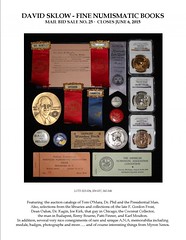 All catalogs have been mailed for Numismatic Literature Mail Bid Sale # 25 Closing Saturday June 6, 2015 at 8 PM Mountain Time. Bidding is
accepted via Email, Fax, Telephone and USPS Mail. There are no changes to our terms of sale.
All catalogs have been mailed for Numismatic Literature Mail Bid Sale # 25 Closing Saturday June 6, 2015 at 8 PM Mountain Time. Bidding is
accepted via Email, Fax, Telephone and USPS Mail. There are no changes to our terms of sale.
The sale contains a vast variety of numismatic literature covering many aspects of the hobby. There are also many lots of medals, badges, pins, photographs and rare memorabilia of the American Numismatic Association. The first consignment contains over 200 lots of early auction catalogs! Within the over 1000 lots offered there is nearly something for every collector, researcher or just plain book lover.
The catalog is also available for viewing [and downloading] on our web site. All our previous sale catalogs, as well as prices realized are archived there for your viewing.
If you have any questions, we are always ready to help you with your numismatic literature needs, or if you are considering selling your library at auction, we are here to help make it a painless and profitable experience.
Bid or consign with confidence!
David Sklow-Fine Numismatic Books
P.O. Box 6321
Colorado Springs, CO 80934
PH: 719-302-5686
FAX: 719-302-4933
Email: numismaticbooks@aol.com
Web Site: FineNumismaticBooks.com
PLEASURE AND PROFIT LESSONS AT 2015 SUMMER SEMINAR
Two Whitman authors, Ken Bressett and Bob Shippee, will be teaching a valuable interactive course at the American Numismatic Association’s annual Summer Seminar this year. Should be very entertaining, as well as informative. Bob’s recent book (Pleasure and Profit) has been getting a lot of rave reviews from collectors, and of course you can’t go wrong when Ken Bressett is your teacher. This is from the ANA bulletin:
Featured Course for Session 2: Pleasure and Profit: 100 Lessons for Building and Selling a Collection of Rare Coins
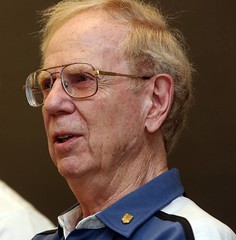 The Session 2 course
"Pleasure and Profit: 100 Lessons for Building and Selling a Collection of Rare Coins," is part of a specialized-interest series.
Instructors Robert W. Shippee and Ken Bressett will focus on how to make collecting pleasurable and profitable. The class will offer
insight into how to make educated decisions when purchasing numismatic items and avoid costly mistakes.
The Session 2 course
"Pleasure and Profit: 100 Lessons for Building and Selling a Collection of Rare Coins," is part of a specialized-interest series.
Instructors Robert W. Shippee and Ken Bressett will focus on how to make collecting pleasurable and profitable. The class will offer
insight into how to make educated decisions when purchasing numismatic items and avoid costly mistakes.
 Each student will leave with a wealth of knowledge in the subject, as well as an
autographed copy of Shippee's book, Pleasure and Profit: 100 Lessons for Buying and Selling a Collection of Rare Coins. Bring
your coins for "show and tell" and be prepared for an interactive experience. A numismatic prize will be awarded each day.
Each student will leave with a wealth of knowledge in the subject, as well as an
autographed copy of Shippee's book, Pleasure and Profit: 100 Lessons for Buying and Selling a Collection of Rare Coins. Bring
your coins for "show and tell" and be prepared for an interactive experience. A numismatic prize will be awarded each day.
Here’s where to register: https://www.money.org/summer-seminar
Session 2 is June 27 through July 2.
I taught a Summer Seminar course a couple years ago with Robert Hoge, Beth Deisher, and Ken Bressett, on writing, editing, research, and publishing in numismatics. It was a lot of fun.
THE BOOK BAZARRE
NEW BOOK: TINNAHS & SEAL SKINS, GOLD DUST & BINGLES
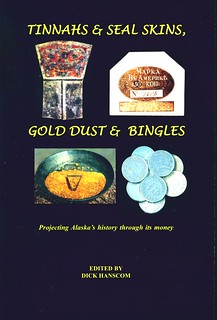 Tinnahs & Seal Skins, Gold Dust & Bingles, Projecting Alaska’s history
through its money. Edited by Dick Hanscom
Tinnahs & Seal Skins, Gold Dust & Bingles, Projecting Alaska’s history
through its money. Edited by Dick Hanscom
The history of a country is often reflected in its money. For Alaska, this is especially true.
Alaska natives may not have had what we consider money, but they did have items that represented wealth. The tinnah (large shield-shaped pieces of copper) represented vast quantities of blankets. A tribe’s “face” rose and fell upon the acquisition and destruction (!) of tinnahs.
The Russian exploitation is expressed in their use of parchment notes, with no real value. With the sale of Alaska to the United States, it was the U.S.’s turn to neglect Alaska. It was the wild, wild “west” in fisheries and sealing.
With the gold rush, things started to look up for Alaska. Wealth, it seemed, was on every creek. Gold dust and tokens were the medium of exchange because any U.S. currency that happened to make it to the territory did a U-turn back to the lower forty-eight to purchase more goods.
All while this was going on, others were developing other sectors of the economy. Gold drove the economy, but other factors were leading to a more stable population.
*****
For this anthology, articles have been gathered from many different sources. Some are not numismatic in nature, but they give information about a location or biography that I think enhances collecting enjoyment.
Many articles have appeared in Alaskan Token Collector & Polar Numismatist over its 37 years. A number have been written by the editor. There are several articles that have been written specifically for this book. Most articles are illustrated with black and white photos.
The book is divided into twelve roughly chronological chapters:
- Tinnahs
- Dentalium & Trade Beads
- Russian American Company
- Fish, Fur & Traders
- Gold Rush
- Promotion & Development
- Bingles
- Personalities – the issuers
- Currency, Scrip & Checks
- Depression – ARRC
- Modern Numismatics
- Personalities – the Collectors
The book is 396 pages, 9” by 6”. The cover is full color with text printed in yellow on black. The paper bound edition is available for immediate shipment for $29.95 post paid by media mail, or $33 via priority mail (U.S. orders only. Please contact us for non-U.S. orders).
Hard bound copies are available on a pre-paid, special order basis for $70. These orders will be accepted until June 15. Delivery will be made in July. Orders can be sent to:
Alaska Rare Coins
551-B Second Ave.
Fairbanks., AK 99701
akcoins@mosquitonet.com
NEW BOOK: NUMISMATIC HISTORY AND ECONOMY IN EPIRUS
Numismatic History and Economy in Epirus during Antiquity
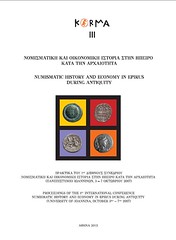 Proceedings of the 1st International Conference: Numismatic History and Economy in
Epirus During Antiquity (University of Ioannina. October 3rd - 7th, 2007) Series Kerma, No. III.
Proceedings of the 1st International Conference: Numismatic History and Economy in
Epirus During Antiquity (University of Ioannina. October 3rd - 7th, 2007) Series Kerma, No. III.
Published by: Lydia Lithos, Society for the Study of Numismatics and Economic History, 2013. This publication was made possible with the
support of the American Numismatic Society.
K. Liampi, et al (eds.)
Soft cover, 660 pp. +50 coin plates.
Price:
Non-member price: US$140.00 plus shipping and handling
ANS Member price and Dealer price: US$99.00 plus shipping and handling
Contact the ANS Membership Office for details if ordering in quantity.
This collective volume is the outcome of an international conference held at the University of Ioannina in October 2007. More than forty papers, reworked and expanded, offer a well-documented picture of the numismatic and economic history of Epirus and the neighboring areas in antiquity. Topics covered include Mints, metrology, prosopography, historiography, iconography, circulation, as well as modern collecting; areas covered are, besides Epirus, also Sicily and the Magna Graecia, owing to their intense relations with Epirus.
Because this publication was supported by the ANS, we are able to extend a discounted price to our members.
For more information, or to order, see:
Numismatic History and Economy in Epirus during Antiquity
(http://numismatics.org/Store/EpirusAntiquity)
NEW BOOK: LATE ROMAN BRONZE COINS
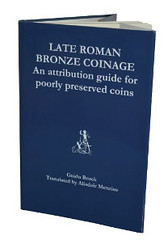 Guido Bruck, Late Roman Bronze Coinage - An attribution guide for poorly preserved coins. Translated by
Alisdair Menzies. 2015, 148 pages, Paperback. ISBN: 978-1502926012. $22.50.
Guido Bruck, Late Roman Bronze Coinage - An attribution guide for poorly preserved coins. Translated by
Alisdair Menzies. 2015, 148 pages, Paperback. ISBN: 978-1502926012. $22.50.
Guido Bruck’s “Die spätrömische Kupferprägung”, published in 1961, has been reedited in English. Alisdair Menzies has taken over this meritorious project which surely will help many friends of Roman coinage to describe poorly preserved coins.
More than fifty years after it went out of print, one of the more unusual and sought after numismatic works on fourth century Roman bronze coins has been reedited and translated into English.
Guido Bruck’s “Die spätrömische Kupferprägung”, originally published in 1961, is now available under the title “Late Roman Bronze Coinage – An attribution guide for poorly preserved coins”.
Amongst the most common ancient artefacts encountered by archaeologists in Europe is the fourth century Roman bronze coin. Relatively few coins, however, are sufficiently well preserved to easily identify using traditional numismatic literature. Guido Bruck, a curator at the Kunsthistorisches Museum in Vienna from 1948 to 1966 had access to the finest collection of late Roman coins in the world, but was also faced with the sometimes fastidious task of having to identify coin finds which were not of museum quality.
Traditional numismatic literature is very much text based. Faced with incomplete or worn specimens, most people would find it very time consuming to come up with a precise identification using traditional texts such as the Roman Imperial Coinage. However, if one pays attention, there are often clues in the images which allow for a precise identification of the type, Emperor or Caesar and mint, even in the absence of complete legends or mintmarks.
The ease of use of this book will be appreciated by both archaeologists and numismatists. It is remarkable how many clues are available if one pays attention. But it should be emphasized that beyond its practical use in identifying coins, this book is valuable in providing a wonderfully illustrated overview of the iconography of the coin types of the fourth century.
You can purchase the book on Amazon.

NEW BOOK: ROYAL COMMEMORATIVE MEDALS 1837-1977. V3
We are currently in our cottage in France, where, away from the tedium of office routine and the tyranny of the ’phone we can devote uninterrupted quality time to making the final tweaks to the book on Anglo-Coins, as well as working on several other forthcoming books.
There were several reasons why we were at home in Wales until the 22nd, not the least of which was space on the ferry to France ! The journey was not easy, with lots of motorway repairs and speed restrictions, and the post office from which we had chosen to post a load of last minute parcels was closed because it was a Wednesday afternoon !
Even so life is serendipitious, and nice things can happen as well as nasty ones. We believe that the journey should always be part of the 'holiday', and as our hobby is eating we like to think that a good meal should be part of the experience. Now the UK does have some good restaurants, the only problem is finding them. And in our case finding ones that are not only good, but affordable. We have given up on the the restaurants in Winchester or Fareham we have tried over the last few years, in Winchester or Fareham, and this time decided to eat in Portsmouth itself, and the road led us to part of the city known as Southsea, which had been the source of happy joint holidays for my step-parents and parents prior to WW2. That suburb has become the University area, which usually means interesting, and sometimes adventurous and cheap food
We drove past an Italian restaurant too fast and turned round at the sea front. We found a Chinese restaurant with a parking space. The menu made much of the fact that Peter Sellers was born in the rooms above the restaurant though I doubt that it was a Chinese restaurant in those days.
We clearly both amazed and disappointed the waiter, for instead of ordering a bottle of something white, nasty and profitable we wanted Chinese tea. We asked him if their chef did ‘real Chinese food’. His reply amazed us: the gist was that the chef did do real Chinese food, but that we would not like it. “Engrish people do not like hot and spicy food”, he told us. I explained that (a) we were not English and (b) we loved spicy food, garlic and chillies. He smiled and went back to the bar, and came back with yet another menu, the third he had shown us !
He warned us, yet again, that the food was very hot and spicy and not for Engrish people. It did not seem particularly cheap either ! However, there many delights, what attracted us most was “Ma po to fu” and “wok grilled squid with chilli”. I ignored the Japanese spelling and as I like squid, we pondered how you grill squid in a wok. We ordered, he went away and we waited.
We watched whilst we waited, the takeaway business, whilst not exactly brisk, was steady, attracting a good cross section of people, some of them older folk looking like retired university lecturers. There were younger folk too, wandering in and out, most of them Chinese. Had we found that place where you could tell that it was a good restaurant by the number of Chinese using it ?
The food arrived fairly quickly and the ma po do foo dish looked exactly right, and so did the squid. Judging from the size of the portions, it was not expensive either. Indeed, as the waiter replaced plates with rice bowls, and cutlery with chopsticks, Bente, wondered whether we’d eat it all. She poked around in the squid dish and triumphantly produced a piece of what she thought was a mange tout pea, but it turned out to be a chilli ! It was certainly not a meal for the for the faint-hearted. The ‘Ma po do foo’ was a delight, with bean curd in a really tasty broth with many dried red chillies in evidence, though as Bente pointed out, they should be avoided, not because of their heat, but because they had long since given up both their heat and flavour to the broth and although what remained whilst still decorative, it was woody and not worthwhile ingesting. The spicy overtones of Szechuan pepper were evident, but not overpoweringly so, just sufficient to give it a fresh and exciting zing.
The waiter came back to the table to see whether we liked the food. We did, and despite Bente’s initial misgivings about its size, we did manage to do it justice by eating the lot. As we paid the bill I told the waiter that we would return sometime and try the pig’s intestines, pondering whether it was the language of the menu that needed a revamp, but then ‘chitterlings’ is the only alternative ‘naice’ word I can think of for pig’s intestines, and that would probably puzzle anyone born after 1970 ! Given the hot and spicy nature of the food I asked the waiter if the chef was from Szechuan, the area where they make the hottest, most spicy chinese food in China. He said that although he knew that the chef was from near Beijing, but he was not sure if he was from Szechuan Province.
Anyway, this was the best, honest, non-Anglicised Chinese food, we’ve found in the area, though it was certainly not subtle. We certainly want to try it again. As we drove on our way, Bente shouted “Two for one pizza !”
“Couldn’t possibly manage it” I replied. “No”, she said, “that’s what the Italian is offering !”
Funnily enough, pizza was what we had the next night, though I made it myself, you can’t buy bean curd, or Szechuan pepper roun’ by yer in rural France.
France is as good as ever !and we have eaten well using the ingredients available in our local market and shops: new season white asparagus. Strawberry flan (made, not by me, but by a real pattissier), prawn bisque, mussels, whelks, oysters, among other things. Splendid cheeses (particularly Roquefort), and on Tuesday, that costly, but delicious fishy delight that the English call John Dory, but the French call Saint Pierre ! Better than even lemon or Dover sole.
A week or more has been spent going through the A-G book yet again. More typo’s and other errors have been found and removed, page layouts tidied uo and numerous small improvements made, and where appropriate, we have added more enlargements of high quality coins from museum and private collections.
We are also working on a book on Irish Gunmoney, but shortly before we came to France we brought to fruition two new numismatic works. The first is
Royal Commemorative Medals 1837-1977. Volume 3.
Queen Victoria, Diamond Jubilee 1897
By Andrew Whittlestone, and the late Michael Ewing.
It is difficult to believe, that the first edition of this volume was published in 1998, which was 17 years ago. It was almost as popular as the 1887 jubilee medals catalogue, and quickly sold out and has been out of print for almost a decade. In those 17 years much has changed. Photography, printing and computers have all made great advances and we have fully taken advantage of those advances to present the user with indexes of obverse and reverse legends, makers, designers, die cutters and publishers, and an index of registered design numbers as well as a general index. This new, much improved and enlarged edition has 133 A4 size pages (204 x 297mm) with glossy laminated card covers, is well-illustrated throughout with hundreds of high-quality black and white illustrations.
This is now available. We have managed to keep it at the same price as the rest of the volumes available in the series. Price £30 + postage and packing.
More details, including details of postage to the USA and other overseas destinations can be obtained from www.galata.co.uk
NEW BOOK: 17TH CENTURY TOKENS OF SURREY AND SOUTHWARK
SEVENTEENTH CENTURY TRADING TOKENS OF SURREY AND SOUTHWARK
by Tim Everson
Published by and available only from www.galata.co.uk, 2015. 132pp, A4, glossy laminated card covers. Price £37 +£3 p+p to UK addresses. Almost all of the 1000 tokens are illustrated in colour including a possible three halfpence, pennies, square, heart and octagonal shaped pieces, those in Pewter and forgeries. Thirty nine completely new pieces are listed for the first time.
The whole series has been renumbered and there is a concordance with Williamson/Dickinson. The book is completed with indexes of designs/devices, signs, names, trades, and a bibliography.
A unique feature of the book is that it includes a photograph of Francis Holden, one of the issuers of a token listed in the book. Impossible ? No, this statement is quite true !
More details, including details of postage to the USA and other overseas destinations can be obtained from www.galata.co.uk
NEW BOOK: LEGENDS OF TRAVANCORE
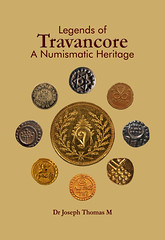 Title: Legends of Travancore - A Numismatic Heritage
Title: Legends of Travancore - A Numismatic Heritage
Author / Editor: Joseph Thomas
Month and Year: May, 2015
ISBN: 978-93-82460-24-4
Book Price (including shipment): 1115 (within India)
About the Book:
The Kingdom of Travancore in the Southern part of India was a native state in British India which was well known for its progressive outlook. Its enlightened royalty ruled the country as Sree Padmanabha Dasa. They had in place a well oiled administrative mechanism that implemented various programs and reforms, resulting in an overall development of Travancore. Though Travancore was under the colonial rulers, there was a well-orchestrated administrative machinery for coinage. Coins were minted as per the specifications ordered by the periodically issued Royal Proclamations. It is creditable that Travancore retained its independence in its functioning to a large extent. This book is an insight into the coins of Modern Travancore (from 1729 AD) which not only reflects the religious beliefs of the rulers, but also sketches the socio-political atmosphere of the period.
About the Author:
Dr Joseph Thomas hailing from Thiruvananthapuram, is a Professor of Urology at Manipal University in India. His passion for collecting coins developed into a serious numismatic pursuit. His special area of interest is the study of the history of Venad and Travancore. His detailed study of the Travancore coins and the various related issues give an insight into the rich numismatic heritage of modern Travancore. He is a Life Member of the Philatelic and Numismatic Association of Thiruvananthapuram and a Life Member of the South Indian Numismatic Society, Chennai
For more information, or to order, see:
Legends of Travancore - A Numismatic Heritage
(http://mup.manipal.edu/BookDetails.aspx?BookId=73&Type=B)
NEW BOOK: TELEPHONE TOKENS OF ASIA
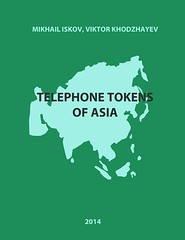 This Catalog of Telephone Tokens of Asia presents the most comprehensive description and full
color photographs of known Asian phone tokens. It covers tokens from Cambodia, Ceylon, China, Hong Kong, India, Indonesia, Israel,
Kazakhstan, Kyrgyzstan, Lebanon, Nepal, Pakistan, Philippines, Asian Part of Russia, Singapore, Syria, Taiwan, Thailand, Turkey,
Turkmenistan, Uzbekistan and Vietnam circulated from the early twentieth century until these countries’ phone companies introduced calling
cards.
This Catalog of Telephone Tokens of Asia presents the most comprehensive description and full
color photographs of known Asian phone tokens. It covers tokens from Cambodia, Ceylon, China, Hong Kong, India, Indonesia, Israel,
Kazakhstan, Kyrgyzstan, Lebanon, Nepal, Pakistan, Philippines, Asian Part of Russia, Singapore, Syria, Taiwan, Thailand, Turkey,
Turkmenistan, Uzbekistan and Vietnam circulated from the early twentieth century until these countries’ phone companies introduced calling
cards.
The catalog contains descriptions of more than 540 Asian telephone tokens from the authors collections and items provided by his fellow collectors from around the world. The catalog's most valuable feature is a well structured and consistent presentation that includes several physical parameters : diameter, thickness, weight, alignment and material the token was made from. The authors also includes the results of their research such as available historical data about issuing telephone companies and circulation patterns. (184 page,A4)
For more information, see:
Catalog "Telephone token of Asia"
(www.facebook.com/telephonetokenasia)
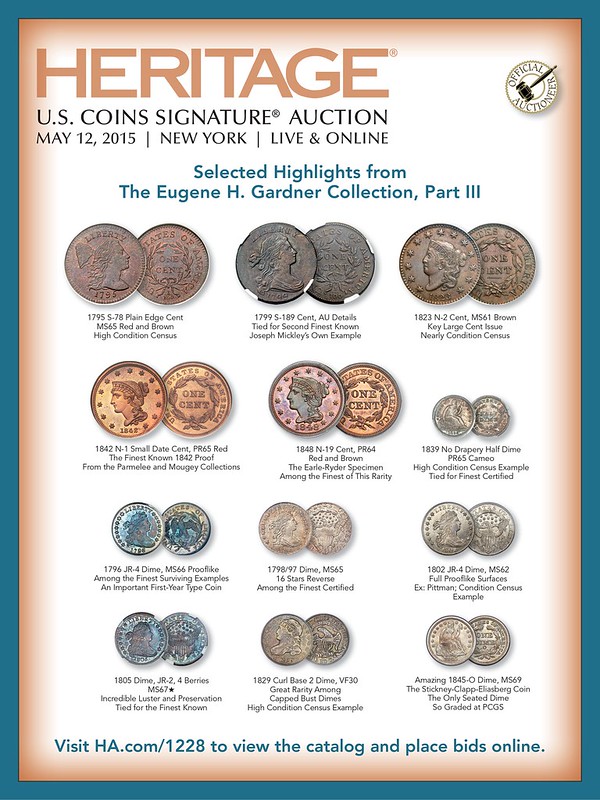
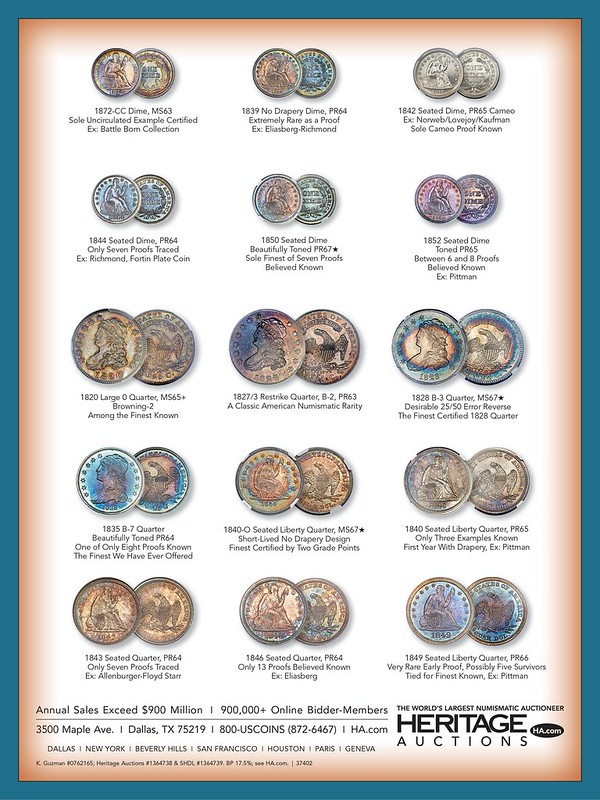
CASSEL U.S. PATTERN COLLECTION OFFERED BY HERITAGE
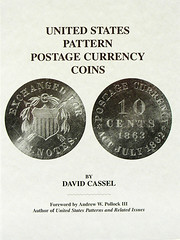 Heritage Auctions will be auctioning the David Cassell collection of U. S. Postage Currency
coins and miscellaneous very special U.S. patterns coins, and five rare gold foreign pattern coins related to the 1868 International
Monetary Convention. Included are coins of United States in aluminum and copper, Five dollar – 25 Francs: in addition, Five coins in gold;
France, 1867, 5 Dollars - 25 Francs (2), 10 Florin 25 Francs, and of Great Britain, 1868; two Double Florin - 5 Francs, one with a plain
edge and one with a reeded edge, each of superb quality and from great collections.
Heritage Auctions will be auctioning the David Cassell collection of U. S. Postage Currency
coins and miscellaneous very special U.S. patterns coins, and five rare gold foreign pattern coins related to the 1868 International
Monetary Convention. Included are coins of United States in aluminum and copper, Five dollar – 25 Francs: in addition, Five coins in gold;
France, 1867, 5 Dollars - 25 Francs (2), 10 Florin 25 Francs, and of Great Britain, 1868; two Double Florin - 5 Francs, one with a plain
edge and one with a reeded edge, each of superb quality and from great collections.
The overall U.S. pattern collection formed by David Cassel from the late 60s’ contains several unique and semi-unique coins. Cassel collected coins of high rarity in a time when most collectors were more interested in acquiring less esoteric and more common regular issue coins. Although he collected pattern coins from a broad range of interests, his passion was the Postage Currency Coins of 1863 and the related coins of 1868 and 1869.
Some Postage Currency coins in the Cassel Collection can be traced back to sales and collections formed in the nineteenth century. Many coins were owned by some of the great names in numismatics; including: Colonel Mendez I. Cohen in 1875, John Work Garrett and family, Robert Coulton Davis PhG. in 1890, George G. Woodside in 1892, Abe Kosoff, Harry Bass, Louis Eliasberg Jr., King Farouk, William H. Woodin, Waldo Newcomer, Lester Merkin, Milton R. Friedberg, and many more.
After Cassel’s discoveries, the Judd books after the Seventh Edition and the major grading services modified their numbering system with new classifications. Many more rare and interesting coins are profiled in his works and included in the Heritage auction.
Cassel has been published in several numismatic articles in Coin World, The E-Sylum, and in the Society of U. S. Pattern Collectors relating to his many discoveries of Postage Currency coin inaccuracies, including: Roulz Alloy has been incorrectly known as Koulz Alloy (Judd 716), certain ten cent coins dated 1868 were actually Mint struck in 1863, and making collectors aware that a host of U.S. pattern coins need to be verified through metal testing as to their correct Judd number assigned.
A very few limited first edition signed and numbered copies of Cassel's book, The United States Pattern Postage Currency Coins are available now on the Kolbe and Fanning web site: www.numislit.com/pages/books/3428/david-cassel/united-states-pattern-postage-currency-coins
SLAVE HIRE BADGES OF CHARLESTON, SOUTH CAROLINA
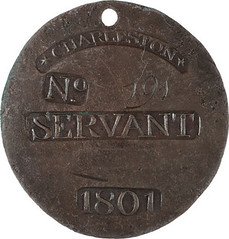 Slavery is one of the darkest realities of America's past; a subject not often comfortably or
openly discussed; a subject many would like to forever blot from our collective memory. The slavery system flourished in most southern
cities during the nineteenth century but, in general, less than one-third of southern white families owned slaves. Many of the others would
hire slave labor on an "as-needed" basis from nearby slaveholders. This custom could prove very profitable for the master,
especially if his slaves had special skills that were in demand. Various cities had laws on the books regulating this practice but
Charleston, through which more slaves were imported than any other city, has the distinction of being the only city with a slave hire
system accompanied by the issuance of what are often called "slave tags."
Slavery is one of the darkest realities of America's past; a subject not often comfortably or
openly discussed; a subject many would like to forever blot from our collective memory. The slavery system flourished in most southern
cities during the nineteenth century but, in general, less than one-third of southern white families owned slaves. Many of the others would
hire slave labor on an "as-needed" basis from nearby slaveholders. This custom could prove very profitable for the master,
especially if his slaves had special skills that were in demand. Various cities had laws on the books regulating this practice but
Charleston, through which more slaves were imported than any other city, has the distinction of being the only city with a slave hire
system accompanied by the issuance of what are often called "slave tags."
Their system allowed a slaveholder to pay a license fee, good for one year at a time, on a sliding scale based on the occupation. In return, he would receive a copper tag or badge for each slave licensed. The master was then allowed to hire that slave out to private individuals, businesses, or even the municipal government with the proviso that the slave would wear the badge at all times when on one of these hire out jobs and that the slave could only perform the function he was licensed to perform. Who benefited from this? The city made thousands of dollars a year in badge fees; the slaveholders made extra money for hiring out slaves that they had no work for at the time; the slaves themselves were often allowed to keep part of their outside wages plus they were given a certain amount of freedom in exchange for their skills.
What were the occupations that are found on these badges? "Servant" is the most common with maybe 60% of the surviving badges bearing that designation. The next most common is "Porter" at roughly 20% of the extant examples. These were considered unskilled or semi-skilled trades and the licensing fees were much lower than the rest. The most "common" of the skilled occupations is "Mechanic" which accounts for about 10% of known badges. The rarest are "Fruiterer", "Carpenter", and "Fisher." Others are thought to have been issued but no confirmed examples survive.
Slave-related memorabilia is a large and popular area of collecting interest. It's interesting to note that these Charleston slave hire badges are really the only things a collector can obtain that can absolutely be guaranteed to have been owned and worn by a slave. The year it was used, the occupation and the location of the slave wearing it can easily be determined. The selection of authentic slave hire badges in this auction is extensive and includes rare occupations. Truly an historic offering!
To view the lots online, see:
http://historical.ha.com/c/search-results.zx?N=49+793+794+792+2088+4294950533+4294966661
PRESS EVENT FOR LEBANESE TOKEN BOOK
Yosef Sa'ar writes:
The video of the press event (in Armenian) for the publishing of "Les jetons-monnaie du Liban" (Tokens of Lebanon) by Hagop Kazazian and Gilbert Bou Fayssal includes images of several old tokens.
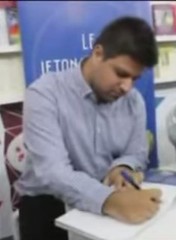
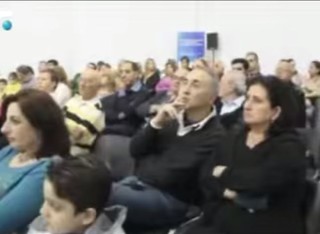
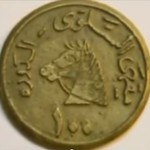
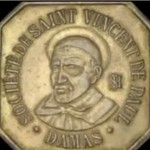
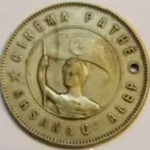

To view the complete video, see:
Les jetons-monnaie du Liban [low-res] (www.youtube.com/watch?v=eX_FmIFyQQk)
To read the earlier E-Sylum article, see:
NEW BOOKS: NUMISMATICA CATALOG, LEBANESE TOKENS
(www.coinbooks.org/esylum_v18n03a06.html)
JOE LEVINE INTERVIEWED ABOUT WHITE HOUSE COLLECTIBLES
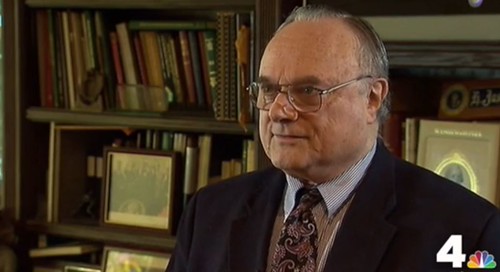
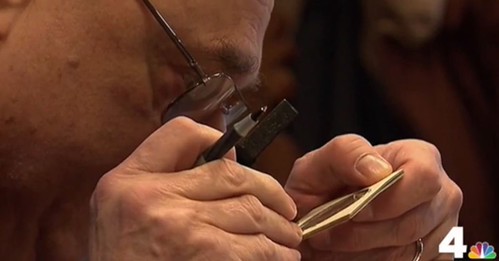
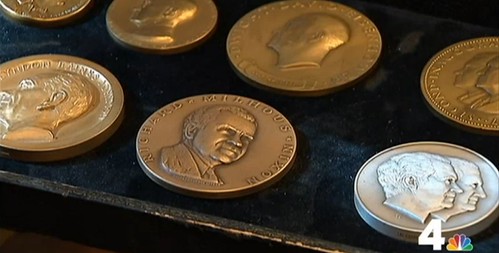
To view the complete video, see:
White House History for Sale
(www.nbcwashington.com/video/#!/news/local/White-House-History-for-Sale/302702931)
NOTES FROM E-SYLUM READERS: MAY 10, 2015
Query: Numismatic Inventory Software Sought
David Gracey writes:
I am looking for a computer program with which I can inventory a collection that includes world coins, tokens, currency, and medals. Can any readers of The E-Sylum recommend such a program?
Gold Washington Before Boston Medal Presentation Case
Alan V. Weinberg writes:
Dave Perkins and I examined up close under glass the gold Washington Before Boston medal during the Boston ANA several years ago. As I recall, The E-Sylum published an up-close picture of us smiling with our chins at medal level.
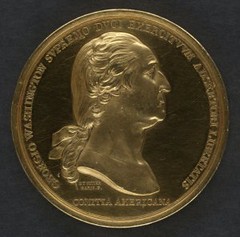 Two things that struck me at the time in Boston. First, the medal was hardly
pristine and shows signs of mishandling in the fields. Its prooflike surfaces were subdued. Second, the case was very mundane and almost
certainly a replacement.
Two things that struck me at the time in Boston. First, the medal was hardly
pristine and shows signs of mishandling in the fields. Its prooflike surfaces were subdued. Second, the case was very mundane and almost
certainly a replacement.
I have hundreds of pre-1900 American gold and silver medals and it is usual for anything of significance to be housed in a plush, specially made presentation case, usually much larger than the medal itself, leather-covered wood with ornate fabric lining.
To read the earlier E-Sylum articles, see:
EXHIBIT: WE ARE ONE (www.coinbooks.org/esylum_v18n18a13.html)
ALAN WEINBERG ON THE 2010 BOSTON ANA CONVENTION
(www.coinbooks.org/esylum_v13n33a09.html)
THE BOOK BAZARRE
19TH CENTURY NUMISMATIC RAFFLES: DANIEL GROUX
Last week I wrote: "There were at least TWO raffles in the world of 19th century American numismatics. What are the others?" Scott Miller writes:
Regarding 19th century numismatic raffles, I believe the American Art Union included medals as possible prizes in its lotteries.
Joel adds:
The good professor was better at projecting grandiose schemes than at fulfilling them.
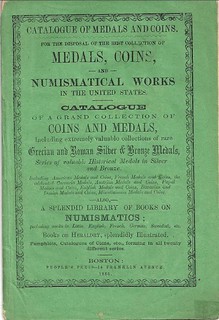
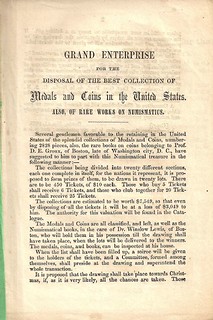
To read the earlier E-Sylum article, see:
1859 SAGE NUMISMATIC BOOKS RAFFLE TOKEN
(www.coinbooks.org/esylum_v18n18a17.html)
NUMISMATIC BOOKS NEVER PUBLISHED
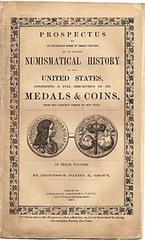 Three timeless American numismatic books — Charles Ira Bushnell’s
History of American Coinage; Daniel Groux’s Numismatical History of the United States; and Ebenezer Locke Mason’s
History of the Rise and Progress of Coin Dealers and Collectors in the United States — are up for discussion today.
Three timeless American numismatic books — Charles Ira Bushnell’s
History of American Coinage; Daniel Groux’s Numismatical History of the United States; and Ebenezer Locke Mason’s
History of the Rise and Progress of Coin Dealers and Collectors in the United States — are up for discussion today.
You say you’ve never heard of these titles? You are not alone. They are “timeless” numismatic books in that they were planned, perhaps even written, but never published.
Len Augsburger, co-author of The Secret History of the First U.S. Mint, suggested that I write about coin books that never were, and those that were published although never finished.
Bushnell had a numismatic cabinet to die for, especially rich in tokens and medals. He was a prickly pear of a man, always eager to quarrel with fellow collectors. One of these adversaries-turned-friends was Augustus B. Sage.
Writing in the February 1867 issue of the American Journal of Numismatics, Sage revealed that since 1858, Bushnell had been occupied with “… a work which, if ever completed, will rank as the only authentic History of American Coinage ever published in this country.” That turned out to be a big “if,” for Bushnell wrote some small monographs on tokens, but never published his comprehensive history.
One of Bushnell’s contemporaries was Daniel Groux, a Swiss émigré who owned a huge collection of coins and medals. He tried for years to unload it, at inflated prices, to American universities or museums, but none bit.
In 1856, Groux issued a handsome prospectus for a projected three-volume set, including one volume consisting entirely of illustrations. Groux cagily demanded that $8 accompany “pre-publication” orders for his Numismatical History, which he refused to refund after the book failed to appear.
Groux the grifter was bad enough, but everyone’s numismatic whipping boy was Mason, whom The American Stamp Mercury and Numismatist described as “an ignoramus who sets himself up as a man of learning.”
In the June 1879 issue of Mason’s Coin Collector’s Herald, Mason was in “man of learning” mode: “We propose, at no distant day, to publish a History of the Rise and Progress of Coin Dealers and Collectors in the United States. …” That day proved much more distant than planned, for Mason’s book never saw the inside of a printer’s shop.
Bushnell, Groux, and Mason — a grumpy antiquarian, a scheming salesman, and a pompous windbag — shared one unfortunate trait: they were better at starting books than at finishing them.
Joel adds:
I completely agree that the biggest loss mentioned in the column was Mason's history of the rise of the coin trade in the U.S. Mason was, as one of his many critics put it, a sort of high-pressure kind of human gas bag, but he was a coin dealer on and off from 1860 nearly to the end of the 19th century, in both Philadelphia and Boston, and it was a history he knew first-hand (and wrote tantalizing snippets about the assorted house organs he published over the years). It would have been wonderful if he had actually written a more substantial work.
To read the complete article, see:
Timeless numismatic books that might have
been; planned but never published (/www.coinworld.com/insights/Timeless-numismatic-books-that-might-have-been.html#)
WAS THIS TYPO PHOTOSHOPPED?
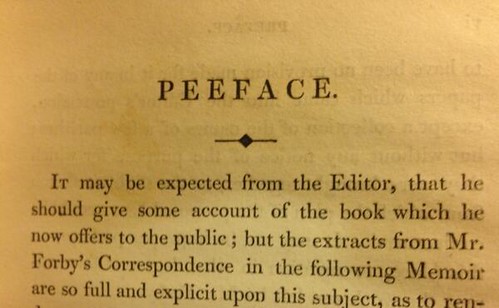
Ron Haller-Williams's first response was:
Photoshopped! See below for how it appears, correctly, on "page v".
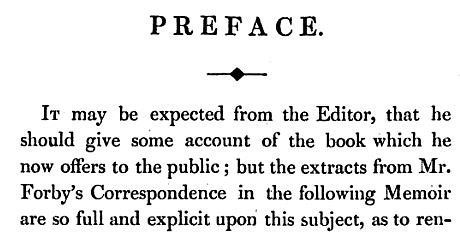
Kavan Ratnatunga agreed. He writes:
Photoshop, since when you enhance and mirror to read what is on the page behind, you see the distortions close to the first E.
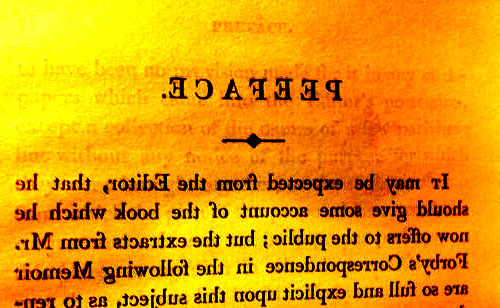
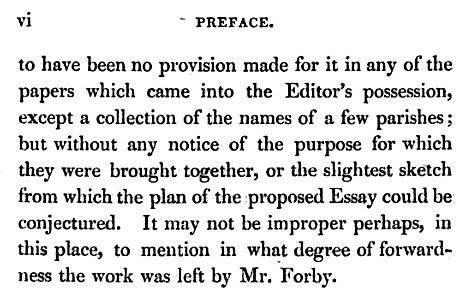
Ron Haller-Williams wrote back:
Sorry, I take it back!!! GENUINE !!!!!! Page 11 of a 336-page PDF is shown below. So it seems to be a genuine error, and some copies must have been printed and released before the error was spotted.
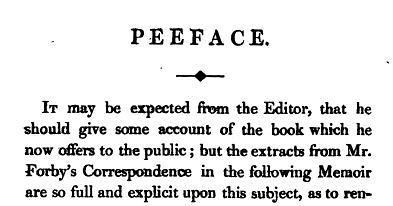
Ron adds:
I must admit that close inspection of what showed through from the other side of the sheet (on the original picture) looked good to me, when you consider what this should have looked like - hence an expert Photoshopper or genuine.
Forgotten Books has quite a lot of interesting material, some of it relevant to our field.
Oh, and in response to one comment on imgur.com, in those days it was normal to put a space on both sides of a colon, semi-colon, etc.; this of course will not be news to many of our E-Sylum readers.
To read the complete Google e-book, see:
The Vocabulary of East-Anglia Etc. - London, J. B. Nicols 1830
(https://books.google.lk/books?id=4tJUAAAAcAAJ)
To read the complete Forgotten Books e-book, see:
The Vocabulary of East Anglia
(www.forgottenbooks.com/books/The_Vocabulary_of_East_Anglia_v1_1000187089)
To read the earlier E-Sylum article, see:
AN 1830 BOOK TYPESETTING ERROR (www.coinbooks.org/esylum_v18n18a30.html)
THE BOOK BAZARRE
NEW ANTI-COUNTERFEITING COINAGE TECHNOLOGY DEBUTS
 The narrow blue ring that separates the map of the earth on the center from the universe on
the surrounding ring on the new German commemorative coin “Planet Erde” (“Planet Earth”) is not made of metal but of a polymer. This
polymer is a little sensation within minting technology. It has been developed by a team that consisted not only of Dr Peter Huber
(Director of the State Mints of Baden-Wuerttemberg) and Günther Waadt (Director of the Bavarian State Mint) but also of representatives of
the German Central Bank, the European Vending Association and coin blanks producer Saxonia. The team brought in additional know-how from
the Leipniz Institute of RWTH Aachen University.
The narrow blue ring that separates the map of the earth on the center from the universe on
the surrounding ring on the new German commemorative coin “Planet Erde” (“Planet Earth”) is not made of metal but of a polymer. This
polymer is a little sensation within minting technology. It has been developed by a team that consisted not only of Dr Peter Huber
(Director of the State Mints of Baden-Wuerttemberg) and Günther Waadt (Director of the Bavarian State Mint) but also of representatives of
the German Central Bank, the European Vending Association and coin blanks producer Saxonia. The team brought in additional know-how from
the Leipniz Institute of RWTH Aachen University.
The fruit of this interdisciplinary collaboration is a polymer that can be coined and meets all requirements of a coin material: it is both chemically resistant and resistant to heat and cold, UV radiation and water.
This unique polymer is not only beautiful to look at but can be applied as a new security feature. Thanks to this material, the very first coins can now be produced that keep up with banknotes in terms of counterfeit prevention. Hence, the German mints have developed an innovation which mints throughout the world are currently searching for. Improving the coins’ counterfeit prevention is considered a prerequisite for raising the value limit between banknotes and coins. Today, this is what many central banks are aiming for. The reason is quite simple: coins may be more expensive to produce than banknotes but they stay in circulation much longer. A lot of money could be saved, if a banknote like the 5 euro note, for example, was replaced by a 5 euro coin.
This is now within reach even though the first 5 euro coin is a commemorative coin “only”. The Ministry of Finance wants “to capture the interest especially of young target groups for German collector coins”.
Anyhow, this commemorative coin is not just a commemorative coin but a milestone in the development of minting technology.
To read the complete article, see:
German Commemorative Coins with Completely New Security Technology
(www.coinsweekly.com/en/News/4?&id=3410)
A CARSON CITY MINT GOLD CLIPPINGS RECEIPT
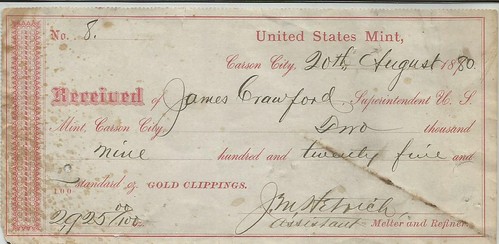
I recently acquired this Carson City Mint receipt and, based upon information contained in From Mine to Mint by noted numismatic researcher Roger W. Burdette and subsequent consultation with the man himself, I believe that the receipt sheds some new light upon the Mint’s internal processes.
To begin with, during the period from 1873 to 1933, gold was deposited with the Superintendent of the Mint and acknowledged with the receipt of the type shown below.
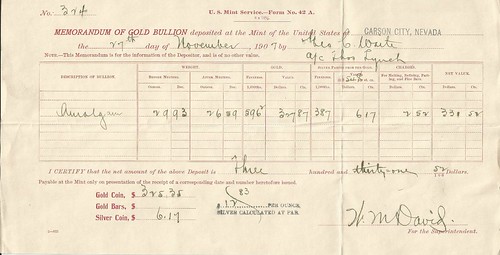
The bullion was then delivered to the Melter & Refiner’s department to be turned into “standard” ingots of 90% gold and 10% alloy. The Melter & Refiner delivered the standard ingots to the Coiner’s department, which then rolled the ingots into coinage strip, cut the blanks and turned the blanks into coins, while the leftover strip was returned to the ingot melting room.
While we know that the Mint’s processes were audited at least annually, that the various departments were only allowed specified “wastage” amounts and that the Mint officers were, through their performance bonds, personally liable for their department’s proper operation, this Gold Clippings Receipt suggests that the Mint’s bookkeeping processes were quite formal.
This Receipt represents a fair amount of money: denominated in 2,925 standard ounces of gold valued at $18.60 each, it represents about $54,400.00. Because it is for “gold clippings”, I believe that it documents the delivery of coining strip leftovers (after coin blanks had been punched out) from the Coiner’s Department.
If I am correct, then this Receipt is particularly interesting because it shows that inter-department transfers of precious metal were not made directly to one operating department from another, e.g., to the Melter & Refiner from the Coiner, but were instead made through the Superintendent’s office. One could infer that the Mint’s administrators sought to eliminate the possibility of “back-scratching” behavior by the operating departments or that they wished to tie the Superintendent to every step of the production process, even though the department officers were personally liable for financial losses in their departments.
In any event, the presence of this Receipt implies that there was a matching receipt that documented the delivery of 2,925 standard ounces of gold clippings to the Superintendent from the Coiner.
For those who are not that familiar with the Carson City Mint, 1880 was a busier gold minting year than the previous three. Carson City produced 51,017 half eagles and 11,190 eagles, which used about 18,300 ounces of standard gold.
This Receipt was issued to Superintendent James Crawford, who was in office from late 1874 (appointed in September, formally nominated by President Grant and confirmed by the US Senate in December) until his death in March 1885 (following which coinage was suspended at the Carson City Mint until July 1, 1889). The Receipt was given by Josiah M. Hetrich, who is first listed as a “Cupeller” in the Carson City Mint in September 1875, next as “Humid Assayer” in September 1877, and “Melter & Refiner’s Assistant” in September 1879. He was nominated to be Assayer of the Carson City Mint by President Hayes and confirmed by the US Senate in December 1880. He presumably served as Assayer until the Carson City Mint was temporarily closed in November 1885.
Mr. Hetrich was the brother of Frank D. Hetrich, who had a long career as an assayer, first in the assay department at the Denver Mint in 1865, then as Assayer (from December 1869 to mid-1873) and Superintendent (July 1873 to July 1874) of the Carson City Mint and finally as an employee in the Assay Department of the San Francisco Mint from November 1874 through at least mid-1893.
Internal Mint receipts of this type seem to be uncommon. While I haven’t scoured auction archives, I can only point to two examples: Mr. Burdette illustrates an 1871 receipt from the Philadelphia Mint for silver coin on page 356 of From Mine to Mint and reports that these receipts were discarded after use; and, well-respected coin dealer Bill Shamhart illustrates an 1874 receipt from the Carson City Mint for silver bullion on his Numismatic Americana website.
Can anyone point out other examples?
To purchase Burdette’s From Mine to Mint, see: www.wizardcoinsupply.com/from-mine-to-mint.html
To view the Carson City Mint receipt at Numismatic Americana’s website, see: www.numismaticamericana.com/americana-offerings/united-states-mint-at-carson-city-receipt-for-silver-bullion-1874/
MORE EMPEROR NORTON PROJECTS UNDERWAY
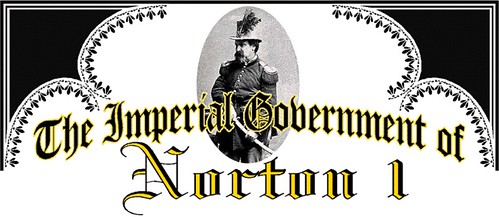
Regarding last week's item on Emperor Norton and his seal, John Lumea writes:
Thanks so much for picking up my recent piece for The Emperor's Bridge Campaign, on David Hutchinson's donation of Emperor Norton ephemera to the Odd Fellows. I'm still fascinated by that discovery.
Our bridge-naming project now is positioned as more of a "Campaign within the Campaign." We've been building out a larger cultural-historical mission that includes a variety of projects intended to honor the life and advance the legacy of the Emperor.
- Historical Sources Project
- OCR Correction Project
- Historical Mapping Project
- Art, Music & Ephemera Project
- Emperor's Birth Date Research Project
- Biographical Reprints Project
- Project to Name the Bay Bridge for the Emperor (Too)
- Public Sculpture Project
For more information on the group's Emperor Norton projects, see:
www.emperorsbridge.org/projects/projects/
To read the earlier E-Sylum article, see:
EMPEROR NORTON'S PROCLAMATION AND SEAL
(www.coinbooks.org/esylum_v18n18a22.html)
ARTICLE PROFILES BOOK AUTHOR JOSEPH THOMAS M.
 It is
a far cry from the cowrie shells of ancient times to the present day credit cards or plastic money used in transactions, but the transition
reflects the evolution of money. Numismatics has been generally considered the domain of students of history who rely on it as a source of
information. For Joseph Thomas M., a physician, his interest in history developed as a natural outcome of his childhood hobby of collecting
coins.
It is
a far cry from the cowrie shells of ancient times to the present day credit cards or plastic money used in transactions, but the transition
reflects the evolution of money. Numismatics has been generally considered the domain of students of history who rely on it as a source of
information. For Joseph Thomas M., a physician, his interest in history developed as a natural outcome of his childhood hobby of collecting
coins.
“Growing up in Thiruvananthapuram, it was not difficult to acquire coins particularly because I am a third generation resident of the city. I naturally had access to coins in circulation during my grandfather’s time. That was just a fancy. The collection kept growing. But it was in the last 15 years or so that coins have become a serious passion for me,” says Dr. Joseph, a urologist in Kasturba Medical College, Manipal.
His progression from a mere coin collector to a genuine numismatist who learnt to use the coins to reconstruct the history of a period has found fruition in the book – Legends of Travancore – A Numismatic Heritage.
How did he zero in on the coins of erstwhile Travancore as the subject for the book? “With a collection of coins from 300 countries (some of these countries have ceased to be, for instance, East European nations such as Yugoslavia, Czechoslovakia) and the numbers growing, I gradually narrowed down my interest to the coins of colonial India,” he says. Once the colonial powers set foot on the sub-continent, barter system gradually made way for more a concrete payment arrangement. The native states started their own methods of minting coins.
Travancore and Venad became the focal point of his study. “For my personal use, I made a reference book that was a combination of catalogue-cum-history. Since access and availability of documents on the Travancore era were easier than the Venad phase of history, I commenced work on Travancore,” explains Dr. Joseph.
The book draws on coins from ancient Travancore to narrate the political history, as well as the manner in which the coins were used within the social hierarchy. Since coinage fell within the Diwan’s functions, the mints of Travancore were located in different places, Padmanabhapuram, Kollam, Mavelikara and the Paravoor. Wherever there was a Cutchery, there was a mint. An interesting feature, according to the author, is that every mint (Kammattam) had a temple with Ganapathy as the presiding deity! Gazette notifications regarding such temples exist to confirm the practice of having a Ganapathy temple adjacent or close to the mint.
The book, according to the author, offers illuminating details on the use of coins within the social hierarchy, the coming of the kaashu, phanam, chuckram, practice of thulabharam by the rulers, how the first machine-struck coins were issued under Maharaja Ayilyam Thirunal, changing dynamics in minting with the arrival of the British Resident, procuring coins from the Birmingham and Bombay mints, how documents reveal methods of identifying counterfeit coins, all nuggets that are interesting facets of Travancore history.
To read the complete article, see:
Every coin counts
(www.thehindu.com/features/metroplus/interview-with-joseph-thomas-m/article7185101.ece)

LAURIE KOSS DESIGNS CANADA'S 2015 $20 COIN
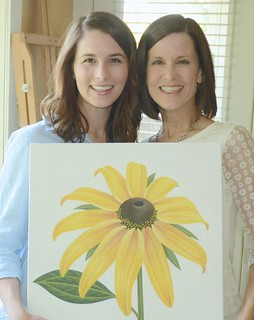 Call it a premonition, coincidence or just plain fate.
Call it a premonition, coincidence or just plain fate.
But when nine-year-old Sarah Koss read a story about a young girl's father who painted the design for a coin, she thought that would be very cool if that happened to her.
That was 14 years ago. But the story stuck with her.
Now 23, that story did in fact play out in Sarah's life. Last year her mom—Kelowna painter Laurie Koss—was asked by the Royal Canadian Mint to submit a painting of a flower for the design of the 2015 $20 fine silver coin. This week that painting, reproduced on a collector's coin, was released by the Mint as part of a series featuring some of Canada's most beloved flowers.
"I used to read American Girl magazine all the time and I still have piles of them in the basement," said Sarah this week of the story that stuck with her. "That was the one article that really stood out to me. I just thought it was so cool."
The release of the silver coin—a collector's item that retails for $119.95—comes less than a year after Koss also designed a stamp for Canada Post.
Both the stamp and the coin feature Koss' trademark floral paintings. After this year's stamp was released featuring a pansy, Koss designed the coin painting a flower known as a black-eyed Susan with twelve bright yellow petals spread out from the prominent dark brown centre.
Once the coin was released this week, Sarah posted a status on Facebook about her earlier experience of reading that story as a child and her wish that one of her parents could make that happen for her.
She called it a dream come true. And mom Laurie was thrilled.
"The fact my daughter would read a story at age nine and to actually have it come true is bizarre," said Laurie. "It just warmed my heart to read that. It's hard to describe my feelings. I'm very honoured and a little choked up. I feel incredibly blessed."
 The 2015
Black Eyed Susan, with crystal dew drops, coin is available at any post office or at mint.ca.
The 2015
Black Eyed Susan, with crystal dew drops, coin is available at any post office or at mint.ca.
To read the complete article, see:
Kelowna mom and daughter united over Royal Canadian Mint coin
(www.kelownacapnews.com/news/303079331.html)
LIBRARY REDISCOVERS AUSTRALIA'S FIRST POUND NOTE
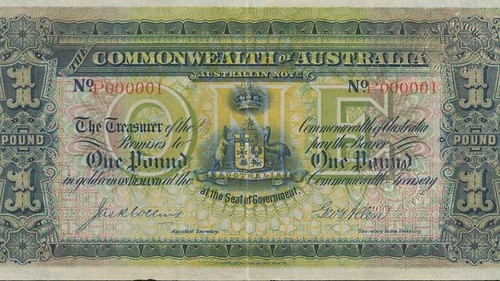
The National Library has found Australia's first pound note, thought to be lost to history for nearly 80 years, in its very own archives.
The note, marked with the serial number P000001 was the first piece of currency to carry the Australian Coat of Arms.
Despite its significance, the note's discovery came about purely by chance.
A coin dealer, looking to sell Australia's first 10-shilling note to the library, alerted them to his suspicions that the note lay within their collection.
That sparked a search of the National Library's myriad of manuscript files.
"The manuscript collection altogether has 12,000 collections and some of those collections are one item or one box. Other collections have many hundreds of boxes and thousands of items," curator Kylie Scroope said.
"The first place we started looking was in the personal papers of then prime minister Andrew Fisher.
"We knew that Mr Fisher had an association with the establishment of this currency, and the printing."
The search of Mr Fisher's personal papers turned up nothing, so the search widened to the entire collection.
"Then it became a matter of using the library's catalogue to search for any collection that had a description that made reference to currency or banknote," Ms Scroope said.
Eventually the note was found in a collection said to contain specimen bank notes.
The one-pound note was presented to Mr Fisher by the Treasury in 1913.
He kept it until 1927, when he passed it on to then prime minister Stanley Bruce, for donation to the Parliamentary Library.
"The Parliamentary Library and the National Library at that stage were a single institution," Ms Scroope said.
Despite records of the donation at the National Archives of Australia, the note went largely unnoticed for the next 80 years.
But Ms Scroope said someone must have found the note in the archives and placed it into a conservation sleeve sometime in the past 30 years.
"In the 20 or 30 years since those sorts of materials came about, but we don't know when that happened," Ms Scroope said.
She said it was difficult to tell what other treasures may be in the National Library's possession.
"Until someone starts looking in the boxes you never know what might be lurking there."
The note is set to go on public display at the library from Monday.
To read the complete article, see:
National Library finds
Australia's first pound note, thought to be lost for nearly 80 years
(www.abc.net.au/news/2015-05-05/national-library-finds-australias-first-pound-note/6446022)
WHERE'S GEORGE $2 BILL TRAVELS 1,700 MILES
Two Dollar Bill, Serial# I6776---3A Series: 2003
This bill has traveled at least 1,717 Miles in 6 Yrs, 262 Days, 5 Hrs, 19 Mins at an average of 0.70 Miles per day.
The bill is now 1,164 Miles from its starting location. This travel history below is in reverse-chronological order
07-May-2015 03:16 PM Texas, USA
User's Note Mom gave it to me for luck!
26-Nov-2012 06:05 PM Florida, USA
User's Note very good condition
04-Sep-2010 10:09 PM Virginia, USA
User's Note I got this bill at a Chevy Chase bank branch in Herndon, VA.
18-Aug-2008 10:58 AM District of Columbia, USA Initial Entry
To read the complete Where's George listing, see:
Where's George? Bill Tracking Report : Two Dollar Bill, Serial# I6776---3A Series:
2003 (www.wheresgeorge.com/b:2cNIVo76v)

2014 IBNS BANK NOTE OF THE YEAR WINNER
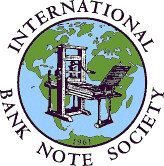 The International Bank Note Society (IBNS) announces that its voting
membership has for the first time ever selected the Central Bank of Trinidad and Tobago to receive it prestigious “Bank Note of the Year
Award” for 2014. With over 130 new banknotes released worldwide in 2014, nearly 3 dozen were of sufficiently new design to be eligible for
nomination. The 50 Dollar polymer Trinidad and Tobago note was followed in voting by the 5000 Franc note from the French Pacific
Territories (Tahiti) and the 10 Dinar bill from Kuwait.
The International Bank Note Society (IBNS) announces that its voting
membership has for the first time ever selected the Central Bank of Trinidad and Tobago to receive it prestigious “Bank Note of the Year
Award” for 2014. With over 130 new banknotes released worldwide in 2014, nearly 3 dozen were of sufficiently new design to be eligible for
nomination. The 50 Dollar polymer Trinidad and Tobago note was followed in voting by the 5000 Franc note from the French Pacific
Territories (Tahiti) and the 10 Dinar bill from Kuwait.
Now in its 54th year, the IBNS has over 2000 members worldwide. As a nonprofit educational organization its objectives are to promote, stimulate and advance the study, collection and dissemination of information related to paper money. From all significantly newly designed and widely circulated banknotes released in 2014, the IBNS membership nominated notes from 12 different countries to place on the ballot. Nominees represented three continents (Europe, Asia & Africa), the Middle East, and 4 island nations (2 in the Americas). Past “Bank Note of the Year” winners include Kazakhstan (2013, 2012, 2011), Uganda (2010), Bermuda (2009), Samoa (2008), Scotland (2007), Comoros (2006), Faeroe Islands (2005) and Canada (2004).
The 2014 winning banknote was produced collaboratively by the Central Bank of Trinidad and Tobago and De La Rue Currency of England. It is the first Central Bank in the Caribbean to issue polymer currency. While the 50 Dollar award- winning bill fittingly commemorates the Central Bank’s Golden Anniversary, “it is meant to be used for all your purchases, like you would any other money.” The note is virtually identical in size to United States bills with a face value of almost 8 U.S. Dollars, 7 Euros or 5 British Pounds at early May 2015 exchange rates.

The stunning design, predominantly gold in color, interprets an artist’s rendering of a red hibiscus flower and truly striking image of a red capped cardinal bird in flight against the clear transparent polymer plastic window. The back of the note features a young female masquerader in an award-winning Carnival costume along with the Central Bank building. Modern polymer banknotes have enjoyed increasing popularity since their introduction in 1988. They offer durability as well as enhanced security features and have become a favorite of many collectors. A full color image of this and other nominated banknotes are on the IBNS website.
The IBNS is open to membership from interested persons in any country. Details concerning all IBNS activities are available at www.theibns.org.
BANK OF THAILAND 500,000-BAHT COMMEMORATIVE
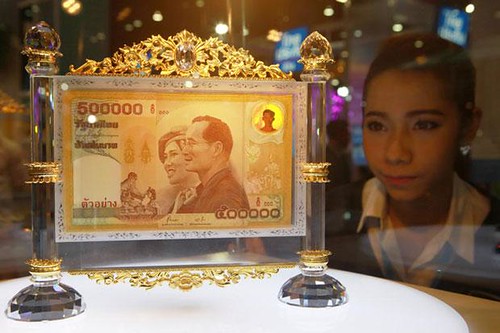
The Bank of Thailand is offering commemorative 500,000-baht banknotes for 1 million baht each at the Money Expo underway at Impact Muang Thong Thani.
Central bank spokesman Jirathep Seneewongse na Ayudhya said the bills were issued to commemorate the 50th anniversary of the wedding of Their Majesties the the King and Queen on April 28, 2000.
There were 1,998 banknotes printed and they were first distributed to the public on May 5, 2000.
The BOT was asked by the fair organiser to exhibit the special banknote at the BoT's booth, said Mr Jirathep.
To read the complete article, see:
Get a B500,000 commemorative
banknote ... for B1m (www.bangkokpost.com/business/news/554319/get-a-b500000-commemorative-banknote-for-b1m)
THAILAND LOTTERY TICKETS
In an extreme move, the National Council for Peace and Order (NCPO) has invoked Section 44 of the interim charter — rule by diktat — as a weapon against overpriced lottery tickets.
The NCPO has also appointed a major-general as the new chairman of the board of the Government Lottery Office (GLO). His appointment will lead to direct military oversight and potential prison sentences for those who sell tickets at more than face value.
If successful, the approximately 17 million people aged 18 and over who spend about 6% of their income on the national lottery will benefit from the 33% reduction in price.
Although most consumers of the lottery are not statisticians, they have a clear sense of which tickets they desire. In short, tickets with three or more numbers that are the same are left untouched. The total cost of these unsold tickets is close to 2 billion baht per annum. This cost is indirectly passed on to the buyers and is partially accountable for the high price of tickets. And, even though the probability of any number being drawn is identical, people still buy the ticket numbers they think will win.
Moreover, seeing the opportunity for making a fortune out of tickets with better perceived chances of winning, the five major lottery operators — which, in practice, form a syndicate — offer to buy all the tickets, including unattractive numbers, from the individuals and the government agencies that have the lottery quota allotment from the GLO.
To read the complete article, see:
Lotto's number is up if S44 fails
to work (www.bangkokpost.com/opinion/opinion/552291/lotto-number-is-up-if-s44-fails-to-work)
There are many lottery ticket collectors in Thailand. This site below has an excellent information and an image of a modern Thai lottery ticket. There was another lottery ticket system before 1974. All lottery systems are called voluntary tax systems in my research.
To read the complete article, see:
2. Thailand’s Lotto Explanation (Legal and Illegal)
(www.onlinebetting.com/legal/thailand/lottery/)
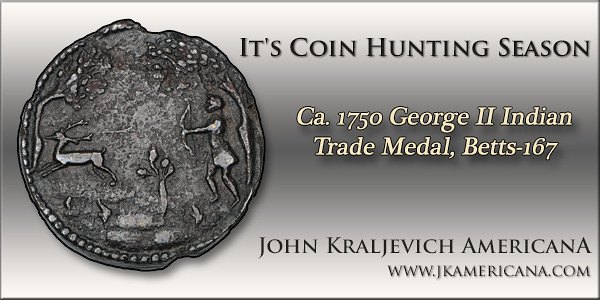
BRITISH ORPHANAGE ASYLUM MEDAL
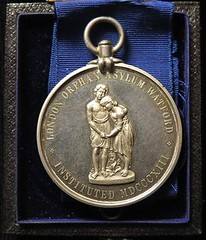 An exceptionally rare medal from Watford's Victorian asylum days is attracting great interest
at a Suffolk auctioneers.
An exceptionally rare medal from Watford's Victorian asylum days is attracting great interest
at a Suffolk auctioneers.
The British Orphanage Asylum silver medal, presented in Watford in 1878, is with Lockdales of Martlesham ready for sale on May 16.
Auction manager James Sadler said: "I’ve never seen such a medal before in all my years in this business. It’s so unusual."
It was presented to a member of staff at the London Orphan Asylum facility at Watford for good conduct and proficiency.
The front of the medal, which has a Lockdales catalogue guide price of £100 to £120, shows a man comforting a distressed woman. The medal comes in a case with a torn ribbon.
To read the complete article, see:
Rare medal
from Watford attracts interest at a Suffolk auctioneers (www.watfordobserver.co.uk/news/12933232.Rare_medal
_from_Watford_attracts_interest_at_a_Suffolk_auctioneers/)
To read the earlier E-Sylum article, see:
MORE ON ORPHANAGE TOKENS (www.coinbooks.org/esylum_v18n08a21.html)
QUERY: LOUIS GOLD MEDAL INFORMATION SOUGHT
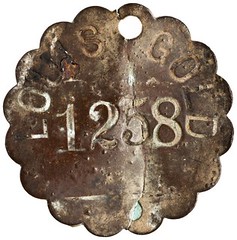
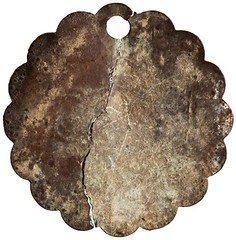
This scalloped-edged medal was found by an amateur archaeologist in fill removed from a building site in downtown Manhattan. Everything else we know about it is on the medal itself, which is inscribed with a name, “LOUIS GOLD” and a number, “1258.” There is no further identifying information on the reverse, though I have included an image anyways. Have an idea about what this might be? Let us know in the comments or send us an email.
To read the complete article, see:
MYSTERIES FROM THE VAULT: LOUIS GOLD MEDAL
(www.anspocketchange.org/mysteries-from-the-vault-louis-gold-medal/)
IS DON DRAPER D.B. COOPER?
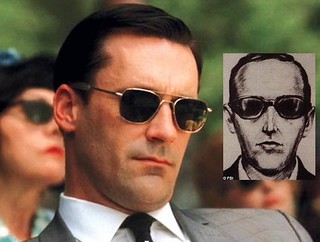 In 1972 a man using the alias D.B. Cooper highjacked a commercial jet flying out of Portland, Oregon
and jumped out with a parachute and $200,000 in cash. He was never seen again.
In 1972 a man using the alias D.B. Cooper highjacked a commercial jet flying out of Portland, Oregon
and jumped out with a parachute and $200,000 in cash. He was never seen again.
Two years ago, Lindsey Green posted a theory that Don Draper is D.B. Cooper. Since then, nothing has happened on the show that blows her theory.
Some observations and ideas (Spoiler alert):
- Don Draper's real name is Richard "Dick" Whitman. He took the name of Lieutenant Don Draper who died in front of Whitman in the Korean war.
- Draper's boss is Bert Cooper. Cooper died on the show. Draper will take the name B. Cooper, and add a D. for Don (or Draper) and give himself a new name: D.B. Cooper.
- In the episode that aired Sunday, Don is sitting in a meeting and realizing his career has hit a dead end. He gazes longingly through the window at a jet.
- The final season of Mad Men takes place in 1972, the same year of the D.B. Cooper incident.
To read the complete article, see:
Mad Men endgame theory: Don Draper is D.B. Cooper
(http://boingboing.net/2015/05/07/mad-men-endgame-theory-don-dr.html)
To read the earlier E-Sylum articles, see:
D. B. COOPER LOOT (www.coinbooks.org/esylum_v05n48a09.html)
D. B. COOPER CASH STASH FOR SALE (www.coinbooks.org/esylum_v10n06a11.html)
PCGS CERTIFIES BRIAN INGRAM'S D.B. COOPER LOOT
(www.coinbooks.org/esylum_v11n08a38.html)

Archives International Auctions, Hong Kong 5
The Alexander I. Pogrebetsky Family Archives of Chinese & Asian Banknotes
Highlights include:
- Lot 2474 Mercantile Bank of India, 1937 Issue
- Lot 2119 Yue Soo Imperil Bank, 1908 Silver Dollar Issue
- Lot 2024 Bank of Territorial Development, 1915 Issue 5 Dollars

1580 Lemoine Avenue, Suite #7
Fort Lee, NJ 07024
Phone: 201-944-4800
Email: info@archivesinternational.com
WWW.ARCHIVESINTERNATIONAL.COM
2015 SWISS SHOOTING TALER AVAILABLE
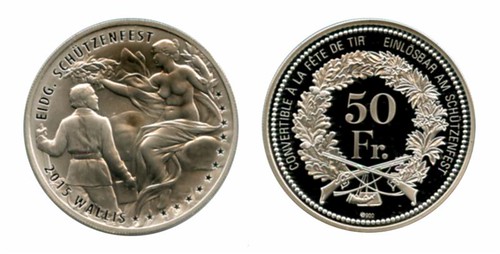
Switzerland’s annual shooting taler is now available.
In modern times, a shooting festival is held every year in a different canton. As many as 50,000 marksmen have attended some of them. The 2015 event is being held in the canton of Valais (Wallis in German) in the southwestern part of the country and home of the Matterhorn.
The obverse shows an allegorical figure sitting naked among billowing drapery, offering an oak and laurel wreath with her right hand and holding a sprig of laurel in her left hand. The denomination is indicated on the reverse with a wreath of oak leaves and laurel around it. Below is a powder horn and ammunition belt hanging from a pair of crossed rifles. The legend states in French and German that the taler is redeemable during the shooting festival. The western part of Valais is French-speaking, while the eastern part uses German.
The Swiss tradition of marksmanship was established during the old Swiss Confederacy in the 15th century, when festival participants used crossbows in shooting contests. The legend of William Tell recalls this tradition as well. The Proof .900 fine silver piece weighs 25 grams, measures 37 millimeters in diameter and has a mintage limit of 1,200 pieces.
For more information, or to order, see:
Switzerland. 50 Francs 2015. Valais Shooting Festival. Silver proof
(www.coin-currency.com/product1137.html)
UGANDANS REJECTING SMALL DENOMINATION COINS
Dick Johnson writes:
I don't know what to make of this news item from Uganda. Interesting reading how Africans view their coins and the worldwide view of eliminating low denomination coins. It does identify the eight denominations currently being used without mentioning the sh50 denomination.
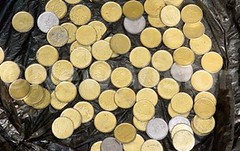 Charles Sengendo, a bodaboda rider at Nakawa in Kampala ordered for food from a local vendor at Nakawa market and consumed it. He turned to
pay for the meal and pulled out the money that included some sh50 coins worth sh300.
Charles Sengendo, a bodaboda rider at Nakawa in Kampala ordered for food from a local vendor at Nakawa market and consumed it. He turned to
pay for the meal and pulled out the money that included some sh50 coins worth sh300.
What surprised him was when the vendor refused to accept the sh50 coins without any reason. He says the vendor forced him to give her any other money. This left him wondering whether the sh50 is no longer legal tender in Uganda.
Another boda-boda rider at Nakawa Bosco Mbonabukya, says he is stuck with sh50 coins worth sh4000 at home and has nowhere to take them. He says he gets them from clients after rendering "our transport services to them."
"We boda-boda riders are forced to accept the coins because we always have nothing to say about it," Mbonabukya says.
The sh50 coin is also being shunned at Universities. Steven Mutebi, a student of Kyambogo University cannot even remember when he last used the coin to make transactions because the coin has totally lost value and cannot purchase anything in Uganda.
Evelyne Karungi, a mobile money operator at Nakawa says she accepts the coin in making transactions because it is legal tender but when she gives the coin to her clients, they rarely accept it 'because it is too small and can easily get lost'.
The sh50 denomination was started in 1971 at the start of the late President Idi Amin regime. During the years 1971 – 1975, one dollar was pegged to sh7.14.
Uganda's currency has 13 denominations, eight of which are coins according to Bank of Uganda data. The coins include the sh1, sh2, sh5, sh10, sh50, sh100, sh200 and sh500.
Lawrence Bategeka, an economist says the current trend of shunning the sh50 coin shows that the public is challenging its use as legal tender. He says it does not make sense to carry many bulky sh50 coins to buy a loaf of bread as it is inconvenient.
"If the price structure has changed such that the sh50 coin has been rendered useless, and one has to combine two coins to buy the smallest thing then the Central Bank should recall the sh50 coin and abolish it altogether," Bategeka says.
To read the complete article, see:
Is the sh50 coin becoming irrelevant?
(www.newvision.co.ug/news/667843-is-the-sh50-coin-becoming-irrelevant.html)

HAS 'CAPT. KIDD'S TREASURE' BEEN FOUND?
 Underwater explorers in Madagascar say they have discovered treasure belonging to the
notorious 17th-Century Scottish pirate William Kidd.
Underwater explorers in Madagascar say they have discovered treasure belonging to the
notorious 17th-Century Scottish pirate William Kidd.
A 50kg (7st 9lb) silver bar was brought to shore on Thursday on the island of Sainte Marie, from what is thought to be the wreck of the Adventure Galley.
The bar was presented to Madagascar's president at a special ceremony. US explorer Barry Clifford says he believes there are many more such bars still in the wreck.
Capt Kidd was first appointed by the British authorities to tackle piracy but later became a ruthless criminal and was executed in 1701.
The team believes the bar, marked with what appears to be a letter S and a letter T, has its origins in 17th-Century Bolivia.
It believes the ship it has found was built in England, however there is bound to be scepticism and calls for more proof that the bar was linked to Capt Kidd, our reporter says.
The location of the ship, thought to have sunk in 1698, has been known about for many years but the silver bar was only discovered earlier this week.
To read the complete article, see:
Pirate Captain Kidd's 'treasure' found in Madagascar
(www.bbc.com/news/world-africa-32621444)
S.S. CENTRAL AMERICA COMMEMORATIVE RESTRIKE CLUES
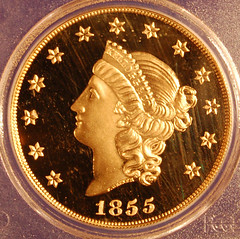
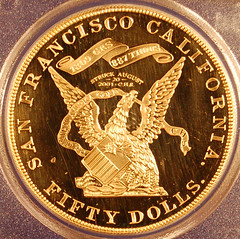
One of the points of contention is the lawsuits is that there are 500 gold “coins” that either are or were in Thompson’s possession. The press coverage sometimes states that these were “commemoratives.” Sometimes it does not. The general public and other reporters don’t understand the subject, and so confusion ensues. A popular misconception has emerged that there is an “unknown amount” of treasure missing. This is not true.
These 500 coins are commemorative re-strikes of the historical 1855 Kellogg & Co. $50 gold pieces. On each day, from August 20 to September 12, 2001, a total of 5,000 of these commemoratives were produced for California Gold Marketing Group by personnel from The Gallery Mint: Ron Landis, Joe Rust and their staff. The coins were minted at The Presidio in San Francisco, commemorating the anniversary of the departure of the S.S. Central America gold from San Francisco, its voyage to Panama, the crossing of the isthmus, and its northbound voyage until lost in the shipwreck.
Landis and Rust used a transfer technique to produce the dies for the re-strikes, expertly copying the original dies from Kellogg, which had survived. The gold for these coins was derived from Kellogg & Humbert ingots recovered from the S.S. Central America, thus using Kellogg gold to re-produce Kellogg’s design. The faces of the ingots, known in numismatic circles now as “faceplates,” were saved, and can be found here and there on bourse floors and in auctions. Attached are photos of the obverse and reverse of a re-strike, in this case produced on August 20, 2001, as counterstamped on the reverse. All of the commemoratives are similarly counterstamped with their production dates.
The coins were minted from gold bars that Thompson’s Columbus-based companies brought up from the SS Central America shipwreck in the late 1980s.
The court document says that Alison Antekeier, Thompson’s longtime assistant and girlfriend, testified that she took delivery of the coins between 2003 and 2005 from Thompson’s company, Recovery Limited. She put them in a safe-deposit box at a Jacksonville, Fla., bank at Thompson’s direction.
She said Thompson directed her to move the coins in 2010 to a secure place in Fort Lauderdale, Fla. Several months later, she packed them into four suitcases and “gave them to a person who Thompson had arranged to transport the coins to Belize and deposit them,” the document says.
To read the complete article, see:
http://www.dispatch.com/content/stories/local/2015/05/01/tommy-thompson-gold-coins.html
/www.dispatch.com/content/stories/local/2015/05/01/tommy-thompson-gold-coins.html)
To read the earlier E-Sylum article, see:
BOB EVANS ON THE DISPOSITION OF THE S.S. CENTRAL AMERICA TREASURE
(www.coinbooks.org/esylum_v16n16a32.html)
THE SIKYON STATER
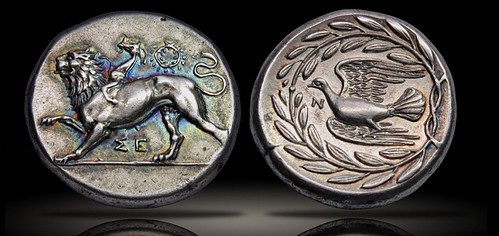
Sikyon was located in the northern Peloponnesus and was known in antiquity for its industries, including sculpture, bronze work, and pottery. Its central location meant it was frequently involved in the wars of its neighbors: Thebes, Corinth, Athens, and Sparta. It was the main mint for the anti-Athenian states in the Peloponnesian War and issued a substantial number of coins, most of which were melted down to finance further conquests.
Sikyon was the cradle of western art, credited with originating tragedy in theater, the modern art of painting as it still stands today, and the invention of using multiple instruments arranged orchestrally. The great sculptors Polykleitos and Lysippos both studied at the famous schools in Sikyon.
This coin comes from an issue of staters produced at Sikyon after Alexander the Great’s request for mercenaries from the Peloponnese in 334 BCE. They seemed to have been paid out as a signing bonus and then buried for safe-keeping. Unfortunately, many of these mercenaries never came back, explaining why many coins of this type still exist today and were never melted down.
The coin depicts a chimera, a mythical, fire-breathing monster composed of parts of three animals: a lion with the head of a goat arising from its back and a tail that ends in a snake’s head, walking proudly to the left in an almost heraldic manner. According to Greek mythology, the chimera was slain by Bellerophon with Apollo’s help, and appeared on most of the major coinage of Sikyon.
A dove is shown on the reverse, representing the main emblem of the city and a symbol of spirit. In antiquity, it was well known that doves were kind, peaceful, and honorable animals, mating for life and working together to build nests and raise their young. Greeks and Romans felt that they represented love and devotion, and it was the sacred animal for multiple goddesses, so it would follow that the iconography on this coin was a depiction of “war and peace”.
To read the complete article, see:
Ancient Coins: War and Peace – The Sikyon
Stater (www.coinweek.com/ancient-coins/ancient-coins-war-and-peace-the-sikyon-stater/)
THE BOOK BAZARRE
CHRISTOPHER MORLEY ON VISITING BOOKSHOPS
There is no mistaking a real book when one meets it. It is like falling in love, and like that colossal adventure it is an experience of great social import. Even as the tranced swain, the book-lover yearns to tell others of his bliss. He writes letters about it, adds it to the postscript of all manner of communications, intrudes it into telephone messages, and insists on his friends writing down the title of the find. Like the simple-hearted betrothed, once certain of his conquest, “I want you to love her, too!” It is a jealous passion also. He feels a little indignant if he finds that any one else has discovered the book, too. He sees an enthusiastic review—very likely in The New Republic—and says, with great scorn, “I read the book three months ago.” There are even some perversions of passion by which a book-lover loses much of his affection for his pet if he sees it too highly commended by some rival critic.
To read the complete article, see:
Christopher Morley at 125 – “On Visiting
Bookshops” (http://fourthgarrideb.com/2015/05/christopher-morley-at-125-on-visiting-bookshops/)
MEDALS FOR MOTHERS
 With Mother’s Day approaching this weekend, I thought it might be a good time for
a post about the many mothers who appear in the collection of the American Numismatic Society. The most common way mothers figure in our
collections is via medallic art, where prominent artists ranging from Oscar Roty (1846-1911) to Victor David Brenner (1871-1924) engraved
medals depicting maternal ideals. Roty’s particularly elegant medal was executed as a memorial of the baptism of his son in 1893.
With Mother’s Day approaching this weekend, I thought it might be a good time for
a post about the many mothers who appear in the collection of the American Numismatic Society. The most common way mothers figure in our
collections is via medallic art, where prominent artists ranging from Oscar Roty (1846-1911) to Victor David Brenner (1871-1924) engraved
medals depicting maternal ideals. Roty’s particularly elegant medal was executed as a memorial of the baptism of his son in 1893.
Brenner’s medal follows Roty rather closely and indeed much of the medallic art concerning motherhood in the Beaux-Arts era traded in these kind of sentimental images.
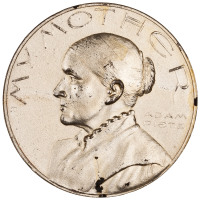 One exceptional item to note in this context is a wonderful medallion by Adam Pietz
(1873-1961) that depicts his own mother in a realistic rather than an idealized fashion.
One exceptional item to note in this context is a wonderful medallion by Adam Pietz
(1873-1961) that depicts his own mother in a realistic rather than an idealized fashion.
 Mother’s Day took on a special significance in the context of World War I when so many mothers had
sons fighting and dying overseas. See the Art of Devastation project for the many ways that mothers featured in the often grim medallic art
and propaganda that accompanied the war.
Mother’s Day took on a special significance in the context of World War I when so many mothers had
sons fighting and dying overseas. See the Art of Devastation project for the many ways that mothers featured in the often grim medallic art
and propaganda that accompanied the war.
To read the complete article, see:
MOTHER’S DAY NUMISMATICS
(www.anspocketchange.org/mothers-day-numismatics/)
FEATURED WEB PAGE: BARBER COIN COLLECTORS' SOCIETY
This week's Featured Web Page is the Barber Coin Collectors' SocietyThe BCCS is a group of coin collectors that are interested in the coins designed by Charles E. Barber, Chief Engraver of the U.S. Mint from 1879 to 1917. He is best known for his Liberty Head designs on the dime, quarter, and half, as well as the popular Liberty Head (or "V") nickel.
The purpose of this site is to provide valuable information and knowledge about Barber coins, details about the Society, and to make it easy for you to participate. Please explore the site, meet with us at major coin shows, and accept our invitation to join.
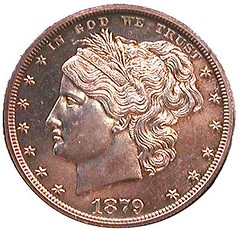
www.barbercoins.org

